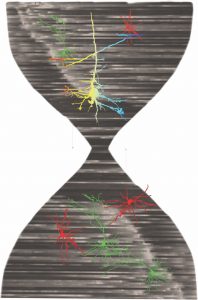How does the brain discriminate between stimulus durations?

There are different models that have been proposed to understand how circuits in the brain distinguish between temporal features in sensory events. According to one model there is a specialized or dedicated brain area that processes information about time – dedicated clock model. An opposing model proposes that time is encoded in the neural dynamics or activity patterns of neural activity in networks- intrinsic network model. My previous work has shown that network activity in vitro can adapt to a particular temporal interval. Specifically, training resulted in an increased likelihood of evoked network activity that is fine-tuned by a time window-specific increase in excitatory–inhibitory balance (Goel and Buonomano, 2016). Using combination of optogenetics, rodent behavior and machine learning techniques our lab is studying the circuit mechanisms that drive these changes in E-I balance during sensory driven behavior in head-fixed mice.
Memories are strongly linked to the temporal sequence of sensory events, thus identifying the fundamental mechanisms underlying durations of sensory events and sequences are vital to understanding cognition and behavior. In a sequence of events did stimulus A or B arrive first? What are the mechanisms encoding temporal sequences? Learning and encoding sequences is crucial in anticipating sensory events and generating timed movements. And often in neurological disorders such as FXS, individuals generate stereotyped sequences or movements, which ultimately contributes to abnormal behavior. For example processing and learning the duration of an interval between syllables and the temporal order of these syllables is critical for producing speech. Another example is interaction with the social environment, such as joint attention, social bonding, planning for the future, which also require estimating time and durations in a sequential fashion. Thus understanding the mechanistic underpinnings of how a sequence of stimulus durations is encoded, will contribute to strategies to ameliorate speech impairments and social cognition. Two hypotheses we are currently investigating are : Sequences or patterns of spatiotemporal sensory input can be encoded in the network as a result of 1) local changes in intrinsic dynamics, 2) or depending on the complexity, might require contribution from a higher order area and intervention by neuromodulators.

